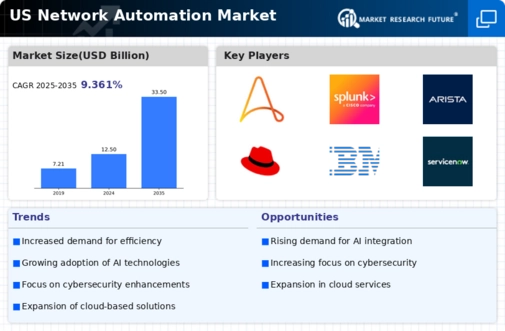Integration of IoT Devices
The proliferation of Internet of Things (IoT) devices is significantly influencing the network automation market. As more devices connect to networks, the complexity of managing these connections increases. This complexity necessitates advanced automation solutions to ensure seamless integration and management. In the US, it is estimated that the number of connected IoT devices will reach 30 billion by 2025, creating a substantial demand for network automation technologies. Organizations are compelled to adopt automation to handle the influx of data and devices, thereby enhancing their operational capabilities and responsiveness. This trend indicates a robust growth trajectory for the network automation market.
Regulatory Compliance Pressures
The network automation market is also being influenced by the pressures of regulatory compliance. Organizations are required to adhere to various industry standards and regulations, which often necessitate the implementation of automated solutions to ensure compliance. In sectors such as finance and healthcare, the cost of non-compliance can be substantial, leading to fines and reputational damage. As a result, businesses are increasingly turning to network automation technologies to facilitate compliance processes. This trend is expected to contribute to the growth of the network automation market, as companies seek to mitigate risks associated with regulatory requirements.
Need for Enhanced Network Security
The increasing frequency of cyber threats is driving organizations to prioritize network security, thereby impacting the network automation market. Businesses are investing in automation solutions that not only streamline operations but also bolster security measures. The market for network security automation is projected to grow at a CAGR of 20% over the next five years, reflecting the urgent need for advanced security protocols. By automating security processes, organizations can respond to threats more swiftly and effectively, reducing the risk of breaches. This heightened focus on security is likely to propel the network automation market forward as companies seek to safeguard their networks.
Rising Demand for Operational Efficiency
The network automation market is experiencing a notable surge in demand for operational efficiency among organizations. Companies are increasingly recognizing the need to streamline their network operations to reduce costs and enhance productivity. According to recent data, organizations that implement network automation solutions can achieve operational cost reductions of up to 30%. This trend is particularly pronounced in sectors such as telecommunications and IT services, where the complexity of network management has escalated. As businesses strive to optimize their resources, the network automation market is likely to see continued growth, driven by the necessity for efficient and agile network infrastructures.
Shift Towards Hybrid Network Environments
The transition to hybrid network environments is reshaping the landscape of the network automation market. Organizations are increasingly adopting a mix of on-premises and cloud-based solutions to enhance flexibility and scalability. This shift necessitates sophisticated automation tools that can manage diverse network architectures seamlessly. As of November 2025, it is estimated that over 60% of enterprises in the US are utilizing hybrid networks, which creates a substantial opportunity for automation providers. The ability to automate processes across various environments not only improves efficiency but also ensures consistent performance, thereby driving growth in the network automation market.






















Leave a Comment